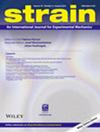用于钢框架结构健康监测的振动数据驱动机器学习架构
IF 1.8
3区 材料科学
Q2 MATERIALS SCIENCE, CHARACTERIZATION & TESTING
引用次数: 2
摘要
设计了一种基于振动数据的机器学习架构,用于钢平面框架结构的结构健康监测(SHM)。该架构使用特征包算法,从注册振动数据的时频尺度图图像中提取加速鲁棒特征(SURF)。然后使用K均值聚类将判别图像特征量化为视觉词汇表。最后,根据识别特征训练支持向量机(SVM)来区分框架结构的未损伤和多重损伤情况。机器学习架构的潜力是针对未在训练中使用的未见过的数据集以及来自接近现有(即训练过的)损伤类别的全新损伤的一些数据集进行测试的。然后将结果与使用其他三种特征和学习算法组合获得的结果进行比较- (i)带有支持向量机的定向梯度直方图(HOG)特征,(ii)带有k近邻(KNN)的SURF特征和(iii)带有KNN的HOG特征。为了检验该方法的稳健性,通过考虑环境可变性以及损害的局部化和量化,进一步扩展了研究。实验结果表明,该机器学习架构能够有效地对未损伤和不同关节损伤类别进行分类,具有较高的测试精度,表明其在此类框架结构中的SHM潜力。本文章由计算机程序翻译,如有差异,请以英文原文为准。
Vibration data‐driven machine learning architecture for structural health monitoring of steel frame structures
A vibration data‐based machine learning architecture is designed for structural health monitoring (SHM) of a steel plane frame structure. This architecture uses a Bag‐of‐Features algorithm that extracts the speeded‐up robust features (SURF) from the time‐frequency scalogram images of the registered vibration data. The discriminative image features are then quantised to a visual vocabulary using K‐means clustering. Finally, a support vector machine (SVM) is trained to distinguish the undamaged and multiple damage cases of the frame structure based on the discriminative features. The potential of the machine learning architecture is tested for an unseen dataset that was not used in training as well as with some datasets from entirely new damages close to existing (i.e., trained) damage classes. The results are then compared with those obtained using three other combinations of features and learning algorithms—(i) histogram of oriented gradients (HOG) feature with SVM, (ii) SURF feature with k‐nearest neighbours (KNN) and (iii) HOG feature with KNN. In order to examine the robustness of the approach, the study is further extended by considering environmental variabilities along with the localisation and quantification of damage. The experimental results show that the machine learning architecture can effectively classify the undamaged and different joint damage classes with high testing accuracy that indicates its SHM potential for such frame structures.
求助全文
通过发布文献求助,成功后即可免费获取论文全文。
去求助
来源期刊

Strain
工程技术-材料科学:表征与测试
CiteScore
4.10
自引率
4.80%
发文量
27
期刊介绍:
Strain is an international journal that contains contributions from leading-edge research on the measurement of the mechanical behaviour of structures and systems. Strain only accepts contributions with sufficient novelty in the design, implementation, and/or validation of experimental methodologies to characterize materials, structures, and systems; i.e. contributions that are limited to the application of established methodologies are outside of the scope of the journal. The journal includes papers from all engineering disciplines that deal with material behaviour and degradation under load, structural design and measurement techniques. Although the thrust of the journal is experimental, numerical simulations and validation are included in the coverage.
Strain welcomes papers that deal with novel work in the following areas:
experimental techniques
non-destructive evaluation techniques
numerical analysis, simulation and validation
residual stress measurement techniques
design of composite structures and components
impact behaviour of materials and structures
signal and image processing
transducer and sensor design
structural health monitoring
biomechanics
extreme environment
micro- and nano-scale testing method.
 求助内容:
求助内容: 应助结果提醒方式:
应助结果提醒方式:


